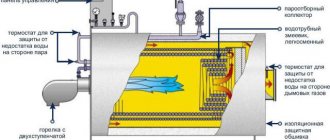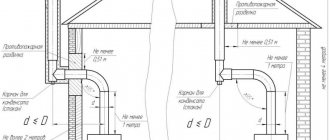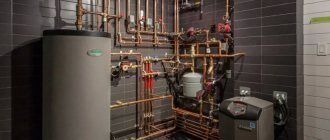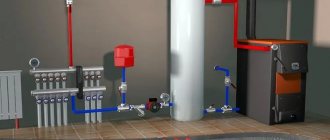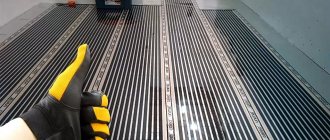Owners of private houses know for sure that an autonomous heating system is much more economical and efficient than a centralized one. Many homeowners trust the solution to the issue of heating their homes to specialists who carry out calculations, design and supervise the arrangement of heat supply.
However, there are also craftsmen who decide to arrange the heating of a private house with their own hands, so as not to overpay for the services of specialists. But this is not a small saving from the family budget, don’t you agree?
Before proceeding with calculations and design, it is necessary to determine the optimal version of the system and its components. We will help you resolve these issues.
The article provides a detailed overview of possible engineering solutions for a private home, identifying the pros and cons of each scheme, the principles of their operation and the nuances of installation.
Modern heating systems
Only an experienced home craftsman can choose a suitable system and install it on his own. Most often, homeowners resort to the services of specialized companies whose specialists are able to make accurate calculations, as well as, using special tools and materials, install system components.
The most common coolant used for heating private homes is ordinary water. In regions with harsh winters, ethylene glycol or propylene glycol can also be used - non-freezing liquids that prevent pipes from freezing and the formation of ice plugs that stop the flow of coolant.
The water is brought to the required temperature using a boiler using available types of combustible materials. The most important task when choosing a heating system is to determine the least expensive type of fuel, as well as the optimal type of boiler, if we consider reliability and costs of purchase, installation and operation.
Criteria for choosing a heat generator
There is simply a huge selection on the market - domestic and foreign manufacturers offer a wide variety of models. From such an assortment, a buyer with any income level will be able to choose something for himself.
In order not to make a mistake when buying a boiler, you need to check what type of fuel is most available in the region
It is also important to correctly calculate the power of the equipment
Advantages of gas units
The vast majority of owners of wooden houses opt for gas equipment.
The popularity of wall-mounted and floor-standing gas boilers is due to the fact that such fuel is one of the cheapest in many countries. In addition, with its help you can organize a completely autonomous and maintenance-free heating system.
The list of advantages of gas boilers needs to be supplemented:
- High efficiency. Even a low-power device generates more heat than its counterparts running on other types of fuel.
- Easy to use. No need to worry about where the fuel will be stored. At the same time, using such equipment is easy - you only need to set it up once.
- Durability. A high-quality gas unit will last at least 15 years.
The main disadvantage is the need to obtain special permission to install it. All other disadvantages are completely offset by advantages.
Diesel component in the system
Diesel-powered equipment has become increasingly popular over the past few years. First of all, liquid fuel boilers are cheap to maintain and easy to install.
At the same time, there is no need to organize a complex chimney design - many models run on light heating oil. The only thing required is to organize the pipe outlet in the form of a sandwich. It has a special turbine that pushes out air.
If you have decided to install a diesel boiler, you need to understand that this heating method will be expensive. After all, the efficiency of this equipment varies from 75 to 85%, which is a rather low figure.
Also, a diesel-powered unit requires constant monitoring. If it is left for at least a week, it will lead to problems. Indeed, due to the low quality of fuel, the equipment may stop. As a result, the water in the pipes will freeze and burst.
Solid fuel boiler
This type of equipment is as popular as gas equipment. Great demand is due to the efficiency and environmental friendliness of solid fuel boilers. After all, such a device is the cheapest device to operate. At the same time, it burns renewable fuel and is highly energy efficient.
The market offers an impressive selection of solid fuel boilers. Savings in this matter are not always justified - if you decide to buy the cheapest model, you need to be prepared for the appearance of soot, soot and come to terms with the need for frequent cleaning.
Electric heat generator
Equipment that uses current in its operation is the only solution for those regions where centralized communication systems are not installed. Most often it is used as an additional option.
Today, manufacturers offer a wide range of electric boilers. Models with power from 6 to 30 kW are available on the market. Such a wide range of performance allows you to order the device for a wooden house of any size.
- small dimensions;
- operational safety;
- complete autonomy;
- cheapness;
- Efficiency approaching 100%.
But keep in mind that electricity is the most expensive energy carrier. Therefore, even despite the low cost of the unit, operating such a system will be expensive.
Power calculation rules
To determine the optimal performance of the boiler, it is not at all necessary to seek help from a specialist. To do this, you only need to determine the amount of heat loss. Knowing this value, it must be multiplied by the area of the house and the resulting number will be the required power.
If the building is not insulated in any way, then heating one square meter will require from 130 to 200 W. For buildings with old windows and a facade that is covered with material that does not allow cold to pass through, the optimal value will be 90-120 W/m2.
As for houses with good thermal insulation of attic and basement floors, plastic double-glazed windows, insulated doorways, properly arranged air exchange, then 50-80 W/m2 will be enough to heat them.
Autonomous heating system using electricity
The air in rooms can be brought to the desired condition not only with the help of radiators through which coolant circulates. Autonomous heating with electricity in a private house allows you to get rid of the purchase of flammable materials and the endless hassle of servicing the firebox.
Electric heating elements are able to bring the temperature in the house to the required value, while the machine will turn off the device in a timely manner, saving an expensive resource.
However, in this case, autonomy is achieved only partially, since any serious accident on power lines can leave the house without heat for a week, which is unacceptable in severe frost conditions.
Video on the topic
How to make autonomous heating in an apartment with your own hands:
The advantage of the owner of an autonomous heating system is that his hands are free: it is possible to supplement the conventional system with alternative heat generators, which will significantly reduce costs. These are solar collectors (vacuum ones are the most effective) and heat pumps that use heat from low-potential sources: water and soil with a temperature of +50 - + 100 C.
Autonomous gas heating system
To avoid going broke on energy bills, many homeowners choose a natural gas system.
- Autonomous gas heating in a private house is carried out due to the supply of propane, a huge supply of which is stored in a gas holder.
- A voluminous metal tank is placed on the surface or underground next to the house. Gas enters the heating boiler through a pipe.
- The gas tank is refilled from a gas carrier once a year or less.
- Compared to other types of fuel boilers, heating with gas from a gas holder is characterized by minimal costs for replenishing fuel reserves, as well as the absence of daily labor costs to maintain the process in the system.
The gas enters the boiler under its own power, and the automation monitors its combustion without human intervention.
Factors influencing the choice of heating boiler for a summer residence
It is believed that the choice of heating for a summer house depends on a number of criteria that must be taken into account in order for the system to be maximum efficient, but at the same time economical in fuel consumption. Among such factors it is customary to highlight the following:
- Indicators of the distance of the structure from all important communication lines such as a boiler room, gas main, etc.
- The distance of the building from a large populated area and gas stations.
- Frequency of time spent in the house. This means that when considering what kind of heating to install in a country house, it is important to focus on whether spending time in a country house will be periodic or permanent.
Experts often recommend the following: if you do not plan to operate the dacha in winter, then it would be more correct to drain all the water from the system immediately before leaving (about
Advantages and disadvantages of an autonomous heating system
The very name of an autonomous heating system implies a refusal of low-quality and expensive services from third-party heat energy suppliers.
Thus, the owner of an autonomous heating system acquires the following advantages:
- Possibility to start and end the heating season in accordance with weather conditions.
- The power of the devices is manually controlled, which allows you to set a comfortable temperature in each room depending on the time of day.
- During periods of absence of people, the system can be turned off or configured to use resources economically.
- The dual-circuit circuit allows you to obtain not only heat, but also hot water for the kitchen and shower.
- The user gains complete freedom from the dictates of the heat supplier, his schedule for turning on and off the batteries. Homeowners become independent from accidents on heating mains and gas pipelines.
When choosing an autonomous heating system, one cannot ignore some of the disadvantages of its use:
- The home owner will have to constantly think about replenishing fuel supplies, looking for the best price, purchasing for future use, transporting and storing flammable materials near the house.
- If we are talking about a solid fuel boiler, you will need to manually load the fuel and remove the ash. Controlling the combustion process takes a lot of time.
- An individual heating system is a set of expensive devices and materials - a boiler, pipes, radiators, pumps, fittings and automatic controls.
- In the case of using electric heaters, the advantages of the choice are largely offset by huge electricity bills.
Technical characteristics of a diesel boiler
Heating installation in a dacha can also be done using boilers operating on diesel fuel. These mechanisms will help to equip a high-quality and efficient heating system, but installing them yourself will be very problematic, since proper installation will require certain skills and knowledge. Among the advantages of diesel boilers, it is customary to highlight the following:
- good performance power;
- reasonable price (the cost of solar oil is less than the cost of the same amount of energy obtained from electricity).
However, such boilers also have disadvantages:
- to install such a unit, you will need a separate room intended for storing diesel fuel;
- the system must be equipped with a high-quality chimney and exhaust hood;
- Solar oil reserves require regular replenishment;
- the operation of the boiler is completely dependent on electricity, so in the event of a power outage, serious problems with the operation of the boiler may occur;
- The combustion products generated during the operation of a diesel fuel boiler can hardly be called environmentally friendly, so there is a mention of harm to human health.
Types of systems
Autonomous heating systems differ according to the following characteristics:
- Type of combustible material. In the field of heating suburban housing, a wide variety of thermal energy generators are used, operating on all available types of combustible materials. This can be gasoline, fuel oil, kerosene, oil, fuel briquettes made from peat, sawdust, husks, corn cobs, hay, and straw. In areas where gas has not yet been supplied or where creating a connection to an existing gas pipeline is too expensive, propane is used, which is filled into the gas tank with a special machine.
- By type of energy. Combustion energy is used, electricity received from a centralized supplier or produced independently - using a diesel generator and solar panels.
- According to the type of transportation of coolant to radiators. The circulation of hot water can be organized according to a single-pipe or two-pipe scheme. A combined method can also be used.
- By type of heat generator. Boilers are used in which combustion energy is transferred to a coolant, which then releases heat to radiators. Electric convectors are also used to heat the air “on site”.
Electric boiler and batteries
Heating with electricity is the second most popular option. Although in terms of operating costs it is often more expensive than coal and firewood. But the electric heating system does not require the constant presence of a person, as well as the organization of a place to store fuel.
There are two ways to heat a cottage using electricity. The first is to install an electric boiler that will provide hot water to radiators or water heated floors. The second way is to heat rooms with electric heaters (convection, infrared, etc.), as well as antifreeze electric floors. There is an opinion that a system with an electric boiler that heats water is more economical - it consumes less electricity. Actually this is not true. Water heating is less economical, as it requires additional energy to operate the circulation pump so that the water does not have time to cool down during circulation. But such a system is more inertial - if the electricity goes out, the water in the pipes and radiators will retain heat for some time and prevent the house from cooling down quickly. But if the house is thoroughly defrosted, the water in the pipes will freeze and the pipes may burst. But it rarely comes to such a domestic catastrophe. On the other hand, when you turn on an electric boiler in a cold house, it will take some time until the boiler heats the water and it carries the heat into the radiators. And at the same time, water heating has another advantage.
By the way, as Ekaterina Pavlenko notes, if the house is heated only with electricity, you can also organize a backup heating option in case of a power outage. For this purpose, an uninterruptible power supply device is installed in the boiler room. It is capable of ensuring the operation of the heating elements of the boiler and rotating the circulation pump in economical mode for up to 4 hours. The cost of such a device is 19-35 thousand rubles. For diesel autonomous power supply stations that are capable of supplying reserve electricity for several days, the price tag can reach up to 500 thousand rubles.
Another interesting addition to the electric heating system can be a hydraulic accumulator. It stores a large volume of heated water, which is used to heat the house when the boiler is turned off. For example, you can heat water at night using cheap electricity at the night rate, and not turn on the boiler at all during the day. This will reduce electricity bills by a third. The cost of a hydraulic accumulator for heating a cottage of 140-160 sq. m. - about 30 thousand rubles.
Step-by-step instructions for beginners
Having no experience in matters of autonomous heating, it is better to give preference to electricity. Although the energy bill can boggle the mind, significant savings arise due to the ease of installation and operation of the device.
In any case, the development of the project and its implementation is carried out according to the following scheme:
- Calculate or order a heating system calculation from specialists.
- Add at least 20% margin to the calculated number of radiator sections. This will allow them to be used effectively throughout their entire service life, when the internal surfaces become coated.
- Radiators are being installed.
- The boiler is being installed.
- Pipes are run from the boiler to the radiators.
- Upon completion of installation, the system is tested for leaks.
If installation skills are not enough, it is better to invite an experienced locksmith, since you cannot allow the house to be flooded with hot water in winter.
Scheme
Any traditional autonomous heating scheme includes a boiler, piping (wiring), and heating devices. When using a system with forced circulation of coolant, a pump crashes into the pipes. Use polymer, steel or copper pipes. The most popular pipeline now is made of polymer materials.
The placement of pipes around the house depends on what principle of water movement is used in the system. In the single-pipe type, water flows from one radiator to another in series. Two-pipe involves connecting two pipes to each radiator. In this case, a hot water pipe is connected to each heating device in parallel.
It should be remembered that the installation of traditional types of heating requires careful implementation of the ventilation design. Safety depends primarily on this.
Photo of autonomous heating in a private house
On what basis are they refusing?
Local executive authorities do not always satisfy requests for the conversion of apartments with heating systems. In judicial practice there are reasonable responses to refusals in proceedings in this area.
Citizens are turning to district courts with statements of claim in which they complain about the decisions of the construction and major repairs departments refusing to renovate and remodel apartments.
Residents did not want to be connected to central heating; they considered it more economical to use an autonomous gas boiler.
The reason for the refusal is in the design of the houses; it does not provide for such heat supply. The building diagram shows that it is impossible to disconnect a separate apartment and completely solve the issues of technical support for individual places in the house with general building communications that are developed in the project.
Heating with electric installations
Rising energy prices have significantly affected the popularity of installing heating systems using electricity. This approach is economically justified only in the absence of other alternative options. Electric fireplaces, convectors, infrared heaters, and heated floors act as coolants in electrical systems.
Advantages of heating with energy carriers:
- relatively low cost of installation equipment;
- it is possible to use electric boilers to obtain hot water supply ;
- environmental friendliness;
- the possibility of automation to maintain optimal temperature conditions in the building;
- no need for expensive maintenance;
- the ability to move the heating device from one room to another.
Minuses:
- high power consumption (up to 24 kW/hour) and considerable cost of electrical media ;
- the need to install additional multiphase distributors ;
- In the event of possible power outages, the entire circuit fails.
Geothermal installation to create a heating circuit
Choose to heat a private home, using the earth's energy resources for this purpose - to obtain an environmentally friendly and economical source of heat for heating a private home. 98% of the sun's energy is accumulated in the soil layers, which is the basis for fuel production. Regardless of the time of year and temperature on the surface, heat is retained in the deep layers of the soil.
A geothermal installation consists of external and internal circuits. The external circuit (heat exchanger) is located below ground level. The internal circuit is a conventional system located in the house and assembled from pipes and heating radiators. The coolant is water or other liquid containing antifreeze. Pros :
- the ability to set up and start up the system in different climatic conditions ;
- environmental Safety ;
- constant receipt of the required amount of thermal energy;
- low operating costs.
Minuses:
- the high cost of purchasing the necessary equipment;
- payback of the installation is possible only after 7-8 years;
- complexity of installation;
- the need to build a collector .
Required documents
The law states that absolutely any home owner has the right to individual heating and disconnection from the central heating system.
To complete the procedure, the owner must provide:
- conclusion of an engineering company on the technical feasibility of re-equipment;
- written consent of all apartment residents;
- documents certifying the ownership of the apartment;
- technical passport of housing;
- a statement drawn up in free form.
The law also requires the provision of a project as one of the main documents in the package. The project is being developed by water and heat supply engineers.
It is also worth entrusting the project to specialists because, sooner or later, independent conversion will be fixed and dismantled with a return to the central heating center, it is good if this happens before the neighbors below are flooded due to improper wiring, installation or cutting of pipes.
The project is compiled exclusively by specialists who calculate the changes. The calculation determines what impact a future shutdown will have on the operation of the heating system in the house. In addition, specialists carry out thermal-hydraulic calculations and calculations of heat transfer from the riser.
Self-installation
It is quite possible to install heating yourself.
There are three types of the most common system design:
- Single-pipe - in it, radiators receive heat through a chain.
- Two-pipe. Hot coolant is distributed sequentially to each battery. Cooling down, it enters a common pipe and returns to the boiler.
- The collector system involves the supply and removal of coolant directly to each radiator. This is the most advantageous option in terms of saving and releasing heat. However, installation of the structure requires a large amount of material.
The system can be supplemented with a membrane tank and a circulation pump.
Based on the presence of a pump, heating systems are distinguished:
- with natural coolant circulation;
- with forced
It is possible to assemble such a heating system with your own hands.
Before doing this, you need to decide on some points:
- source of energy;
- boiler power, taking into account possible heat loss;
- boiler configuration (single-circuit, double-circuit);
- system configuration (one-pipe, two-pipe, manifold);
- number and size of radiators;
- with the type of energy carrier circulation;
- wiring diagram.
After this, it is necessary to outline the sequence of work:
- Insulate the room.
- Tidy up the surface of the walls to which the devices will be attached (this is difficult to do after installation).
- In accordance with the plan, drill holes in the walls for pipes of the appropriate diameter.
- You must read the device installation instructions. Assembly should begin from the boiler, connecting all components in series. The construction uses metal-plastic pipes. They are connected by special devices - fittings. This makes the installation process easier.
- After assembly, it is necessary to test the system for tightness and heat transfer.
In a private house
The heating system of a private household depends on the proximity and type of energy source. Since a home is a permanent place of residence, for installation they strive to choose not so much an economical option as a reliable and convenient one.
In the country
Many summer residents choose a solid fuel boiler for heating. Since the dacha can be used irregularly and has a small area, there is no need to invest significant funds in its maintenance.
In the apartment
Switching from central heating to autonomous heating is a labor-intensive process.
It is possible to disconnect from the centralized system of an apartment building and install individual heating only by completing the following documents:
- permission from the management company to disconnect;
- permission from the local administration to redevelop the apartment;
- permission from a licensed gas company to carry out and install gas equipment (if the choice fell on gas energy);
- consent of all residents of the house to these types of work.
Before you decide to take such a step, you must:
- carefully weigh all the pros and cons of an autonomous heating system;
- calculate the costs of its installation;
- Be sure to consult with a lawyer to ensure the paperwork is completed correctly.
Any unauthorized redevelopment of this nature carries the risk of violating safety standards. This may result in fines.
In some modern multi-storey buildings, individual heating is included in the design. In this case, the developer undertakes to install gas equipment and obtain a permit for it. Then the owner who bought the home can only undergo training at the gas company.
In a garage or other outbuildings
The heating system of a private house can include heating of the garage if it is part of the building.
If the garage is located away from housing, it needs individual heating. Heating with wood and liquid fuel requires good ventilation and a specially equipped place. Its maintenance is a labor-intensive process. If you come to work, then spending a lot of time lighting the stove is irrational.
In this case, an electric convector is the best option:
- it does not require large installation costs;
- quickly warms the room;
- safe to use.
In winter there is not enough work in the garage to worry about high electricity costs. The same applies to other outbuildings.
